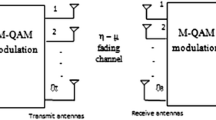Abstract
Multiple-input multiple-output (MIMO) diversity systems with maximum ratio transmission at the transmitter and selection combining at the receiver (MRT/SC) are presented to obtain the tradeoff between the system performance and receiver complexity. Closed-form expressions for average symbol error rate (SER) in single-user scenario and average capacity in multi-user scenario are derived to get the performance of MIMO MRT/SC systems under independent and identically distributed (i.i.d.) Rayleigh fading. Our study shows that performance of MIMO MRT/SC systems outperforms that of MIMO space-time block coding systems. The analytical results are compared with the simulation results and a good agreement is obtained.
Similar content being viewed by others
References
Foschini G. J., Gans M. J. (1998) On limits of wireless communications in a fading environment when using multiple antennas. Wireless Personal communications 6(3): 311–335
Telatar E. (1999) Capacity of multi-antenna Gaussian channels. European Transactions on Telecommunications 10(6): 585–595
Zhou Q., Dai H. (2006) Asymptotic analysis in MIMO MRT/MRC systems. EURASIP Journal on Wireless Communications and Networking 45831: 1–8
Tarokh V., Jafarkhani H., Calderbank A. R. (1999) Space-time block codes from orthogonal designs. EEE Transactions on Information Theory 45(5): 1456–1467
Gozali R., Buehrer R. M., Woerner B. D. (2003) The impact of multiuser diversity on space-time block coding. IEEE Communications Letters 7(5): 213–215
Dighe P. A., Mallik R. K., Jamuar S. S. (2003) Analysis of transmit-receive diversity in Rayleigh fading. IEEE Transactions Communications 51(4): 694–703
Kang M., Alouini M. S. (2003) Largest eigenvalue of complex Wishart matrices and performance analysis of MIMO MRC systems. IEEE Journal selected Areas Communications 21(3): 418–426
Rui X., Jin R., Geng J. (2007) Symbol error rate analysis of multiple-input multiple-output maximal ratio combining systems with self-interference and co-channel interference. IET Communications 1(4): 789–794
Lin, Z., Zhu, G., Xiao, X., & Jian, L. (Sep. 2006). Performance analysis of a new MIMO transmit scheme. In: Proceeding WiCOM (pp. 1–4).
Lo T. K. T. (1999) Maximum ratio transmission. IEEE Transactions Communications 47(10): 1458–1461
David H. A. (1981) Order statistics (2nd edn). Wiley, New York
Proakis J. G. (2001) Digital communications (4th edn). McGraw-Hill, New York
Ajib W., Haccoun D. (2005) An overview of scheduling algorithms in MIMO-based on fourth-generation wireless systems. IEEE Network 19(5): 43–48
Alouini M. S., Goldsmith A. J. (1999) Capacity of Rayleigh fading channels under different adaptive transmission and diversity-combing techniques. IEEE Transactions vehicle Technology 48(4): 1165–1181
Gradshteyn I. S., Ryzhik I. M. (2000) Table of integrals, series, and products (6th edn). Academic, San Diego
Author information
Authors and Affiliations
Corresponding author
Rights and permissions
About this article
Cite this article
Rui, X. Analysis of MIMO MRT/SC Systems. Wireless Pers Commun 62, 117–126 (2012). https://doi.org/10.1007/s11277-010-0042-4
Published:
Issue Date:
DOI: https://doi.org/10.1007/s11277-010-0042-4




